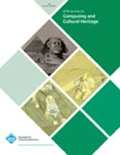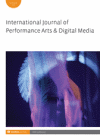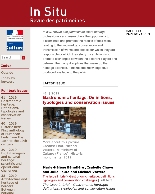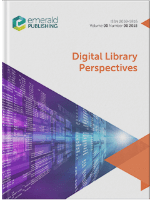
Archeomatica-Tecnologie per i Beni Culturali
Scope & Guideline
Exploring New Frontiers in Cultural Heritage Technologies.
Introduction
Aims and Scopes
- Digital Preservation and Accessibility:
Research in this area emphasizes the use of digital technologies to preserve cultural heritage, enhance accessibility, and create digital representations of artifacts and sites, ensuring their availability for future generations. - Integration of Emerging Technologies:
The journal explores the integration of cutting-edge technologies such as AI, virtual reality, and blockchain into cultural heritage practices, enhancing both the engagement and educational aspects of cultural tourism and heritage. - Interdisciplinary Approaches:
The scope includes interdisciplinary methodologies that combine archaeology, history, and technology, fostering collaboration between universities, museums, and the cultural sector to create innovative solutions for heritage management. - Cultural Education and Outreach:
A significant focus is placed on educational initiatives that utilize digital narratives and immersive experiences to disseminate knowledge about cultural heritage, making it more accessible to diverse audiences. - Sustainability in Cultural Heritage:
Research also addresses the sustainability of cultural heritage practices, emphasizing environmentally friendly technologies and methods that ensure the long-term preservation of heritage sites.
Trending and Emerging
- Digital Transformation in Cultural Heritage:
Recent publications highlight the increasing integration of digital technologies in the management and presentation of cultural heritage, showcasing projects that digitize collections and enhance public access. - Artificial Intelligence in Cultural Heritage:
There is a growing focus on the application of AI technologies in cultural heritage, including AI-based learning for tourism and the use of AI in art creation, which reflects the potential of these technologies to redefine cultural engagement. - Immersive and Interactive Experiences:
The trend towards immersive experiences, such as virtual tours and augmented reality applications, is gaining momentum, emphasizing the importance of engaging audiences in innovative ways to foster a deeper connection with cultural heritage. - Sustainability and Resilience in Heritage Practices:
Emerging themes include sustainability practices in cultural heritage management, focusing on energy-efficient technologies and practices that ensure the resilience of cultural sites against environmental challenges. - Blockchain and NFTs in Cultural Heritage:
The exploration of blockchain technology and non-fungible tokens (NFTs) for the valorization and exchange of cultural assets is an emerging area of interest, indicating a shift towards new models of ownership and engagement in the digital age.
Declining or Waning
- Traditional Archaeological Methods:
There is a waning emphasis on traditional archaeological methods that do not incorporate modern technology, as the field increasingly favors innovative, tech-driven approaches to excavation and analysis. - Physical Artifacts over Digital Representations:
The focus appears to be shifting from the physical study of artifacts to their digital representations, as more research is directed towards creating virtual models and immersive experiences rather than solely examining physical items. - Static Exhibitions:
There is a decreasing interest in static exhibitions that do not utilize interactive or digital components. The trend is moving towards dynamic, technology-enhanced displays that engage audiences in new ways. - Conventional Conservation Techniques:
As technology advances, conventional conservation techniques that do not integrate modern tools and methodologies are becoming less prominent in the journal's publications, indicating a shift towards more innovative practices.
Similar Journals

AIB Studi
Championing accessibility in library research.AIB Studi is a vital peer-reviewed journal published by the ASSOC ITALIANA BIBLIOTECHE-AIB, focusing on the dynamic field of Library and Information Sciences. Since its inception in 2012, the journal has embraced an Open Access model, ensuring that research is accessible to a global audience without financial barriers. Based in Italy, AIB Studi promotes scholarly discourse and innovative practices in the library sector. With an emerging reputation reflected in its 2023 Quartile Rank of Q3 in Library and Information Sciences and a current Scopus ranking of #210/280, it serves as an essential resource for professionals, researchers, and students seeking to advance their knowledge and contributions to the field. The journal publishes articles that delve into the evolving role of libraries in society, explore technological advancements, and examine information management strategies, fostering an environment of collaboration and progressive development in library sciences.

ACM Journal on Computing and Cultural Heritage
Advancing Heritage Preservation with Cutting-Edge Technology.ACM Journal on Computing and Cultural Heritage is a leading scholarly journal published by the Association for Computing Machinery, focusing on the intersection of technology, computing, and the preservation of cultural heritage. Established in 2008, the journal has consistently provided a platform for innovative research that bridges the gap between computational techniques and cultural conservation strategies. With a robust impact factor reflecting its academic rigor and relevance—ranked Q2 in both Computer Graphics and Computer-Aided Design and Computer Science Applications, and Q1 in Conservation—this journal stands out in its ability to foster interdisciplinary collaborations. Notably, it ranks in the top 5% of the Arts and Humanities within its field, highlighting its pivotal role in advancing knowledge and practice in conservation through technology. The journal is vital for researchers, professionals, and students keen on exploring how computing innovations can enhance the safeguarding and interpretation of cultural heritage. Although access options are not distinctly categorized, contributors and readers are invited to engage with the cutting-edge research published through various methods that support scholarly discourse.

International Journal of Performance Arts and Digital Media
Bridging Creativity and Technology for a New Era of ScholarshipInternational Journal of Performance Arts and Digital Media, published by Routledge Journals, Taylor & Francis Ltd, stands at the forefront of interdisciplinary research encompassing the dynamic fields of performance arts and digital media. With an ISSN of 1479-4713 and an E-ISSN of 2040-0934, this esteemed journal has been a vital platform since its inception in 2005, highlighting significant contributions to both Visual Arts and Communication. As evidenced by its impressive rankings—Q1 in Visual Arts and Performing Arts and Q2 in Communication for 2023—the journal's high-impact research caters to a diverse audience, making it invaluable for academics, practitioners, and students alike. Though it follows a traditional subscription model and does not currently offer open access options, the International Journal of Performance Arts and Digital Media remains committed to publishing cutting-edge scholarship and critical dialogues that explore the intricate relationships between artistic expression and digital technologies. Its rigorous peer-review process ensures that all published works meet the highest academic standards, fostering an environment of innovation and creativity within its community.

Revista Eletronica Ventilando Acervos
Connecting Researchers, Professionals, and StudentsRevista Eletronica Ventilando Acervos, with ISSN 2318-6062, is a pioneering academic journal published by the esteemed MUSEU VICTOR MEIRELLES-IBRAM, dedicated to the exploration and dissemination of research in the field of archival studies, museum studies, and heritage conservation. As an open-access journal, it provides unrestricted access to a wealth of scholarly articles, promoting the sharing of knowledge and innovative practices among researchers, professionals, and students alike. Situated in Florianópolis, Brazil, the journal not only showcases local research but also contributes to global discourse on cultural heritage and information management. With a vision to foster collaboration and dialogue within the academic community, Revista Eletronica Ventilando Acervos plays a pivotal role in enriching our understanding of archival science and its impact on society, making it an invaluable resource for anyone engaged in this dynamic field.

Archeologia e Calcolatori
Unveiling the Past with Cutting-Edge Computational InsightsArcheologia e Calcolatori is a distinguished open-access journal published by EDIZIONI ALL INSEGNA GIGLIO SAS in collaboration with the Italian National Research Council, dedicated to advancing knowledge in the fields of archaeology and its intersections with computational methodologies. Since its inception in 1998, the journal has become a pivotal resource for researchers and practitioners, offering a platform for innovative studies and critical discussions at the forefront of archaeological science. With its current impact reflected in Scopus rankings, Archeologia e Calcolatori is placed in Q2 for both Archaeology and Archaeology (Arts and Humanities), and its commitment to quality scholarship is evident. The journal benefits from open access, ensuring that scholarly findings are readily available to a global audience. By prioritizing the dissemination of interdisciplinary research methods and explorative analyses, it aims to foster collaboration and inspire new directions in archaeological and computational research.

Egyptian Journal of Archaeological and Restoration Studies
Illuminating Egypt's Archaeological Treasures.Welcome to the Egyptian Journal of Archaeological and Restoration Studies, a vital resource for scholars and practitioners in the field of archaeology and restoration. Published by the renowned SOHAG UNIV PUBLICATION CENTER-SUPC, this journal aims to disseminate cutting-edge research that illuminates the rich archaeological heritage of Egypt and beyond. With ISSN 2090-4932 and E-ISSN 2090-4940, this journal showcases innovative methodologies and interdisciplinary approaches, significantly contributing to our understanding of cultural heritage preservation. The journal's growing influence is reflected in its Q3 ranking in multiple categories, including Archaeology, Conservation, and Cultural Studies as of 2023, alongside its noteworthy placement within the Social Sciences. Open access options provide wider accessibility to essential studies, making it an indispensable tool for researchers, professionals, and students alike. Join us in exploring the past and shaping the future of archaeological scholarship.

Virtual Archaeology Review
Bridging Heritage and Technology for a Sustainable Tomorrow.Virtual Archaeology Review, published by UNIV POLITECNICA VALENCIA, EDITORIAL UPV, is a distinguished open-access journal dedicated to the dynamic fields of archaeology and conservation. Based in Spain, this journal has made a significant impact in the academic community, reflected in its outstanding Q1 ranking in Archeology and Conservation for 2023, alongside impressive standings in related disciplines such as Computer Science Applications. With an active commitment to promoting the accessibility of knowledge since 2010, it provides a platform for researchers, professionals, and students to share innovative findings and methodologies in virtual archaeology, fostering collaboration across disciplines. The journal's impact factor and its strategic focus on advancing the practice of virtual methodologies in archaeology underscore its vital role in bridging technology and heritage studies. By embracing a multidisciplinary approach, Virtual Archaeology Review not only enhances academic discourse but also drives the development of effective conservation strategies, making it an essential resource for those dedicated to the preservation and appreciation of our cultural heritage.

Mediterranean Archaeology & Archaeometry
Connecting Scholars Across Mediterranean NarrativesMediterranean Archaeology & Archaeometry is a premier academic journal dedicated to advancing the fields of archaeology, anthropology, conservation, and history, published by UK Zhende Publishing Ltd. With its ISSN 1108-9628 and E-ISSN 2241-8121, this journal serves as a vital platform for scholars and practitioners to disseminate innovative research and findings related to the rich archaeological heritage of the Mediterranean region. It has gained remarkable recognition, achieving a Q2 ranking in anthropology and archaeology, and a Q1 classification in several categories including arts and humanities, conservation, and history as of 2023. Its impressive Scopus rankings underscore its impact, with a significant position in history (59/1760) and conservation (11/103) disciplines. Spanning years from 2008 to 2022, the journal invites open access contributions to foster collaboration and interdisciplinary dialogue among researchers, students, and professionals alike, making it an indispensable resource for those engaged in the exploration and preservation of historical narratives within the Mediterranean context.

In Situ-Revue de Patrimoines
Bridging the past and present through scholarly dialogue.In Situ-Revue de Patrimoines is a distinguished open-access journal published by the MINISTERE CULTURE & COMMUNICATION, dedicated to advancing the field of heritage studies. Established in 2001, this journal seeks to foster a deeper understanding of cultural heritage through the dissemination of high-quality research articles, reviews, and case studies that reflect the interdisciplinary nature of the discipline. With an ISSN of 1630-7305, In Situ provides scholars, practitioners, and students with invaluable insights into the preservation, management, and interpretation of cultural assets. By offering open access to its content, the journal ensures that vital knowledge in heritage conservation reaches a broad audience, promoting dialogue and collaboration within the global academic community. Situated in the heart of Paris, In Situ serves as an essential resource for those committed to the stewardship of our shared cultural legacy.

Digital Library Perspectives
Shaping Tomorrow's Information Systems TodayDigital Library Perspectives, published by Emerald Group Publishing Ltd, is a pivotal journal in the dynamic fields of Education, Information Systems, and Library and Information Sciences. With an impressive Scopus ranking that places it in the Q1 category for Library and Information Sciences and Q2 for both Education and Information Systems, this journal has established itself as a significant resource for scholars and practitioners alike. The journal's ISSN is 2059-5816 and its E-ISSN is 2054-1694, facilitating broad accessibility to cutting-edge research and innovative practices within digital library environments. Published since 2016, it continues to offer a platform for the exploration of emerging trends, challenges, and technologies affecting digital libraries and information services. Researchers, professionals, and students will find that the journal not only highlights critical advancements but also fosters discussions around best practices and future directions in the industry. While it operates under a subscription model, it remains a crucial contributor to the scholarly dialogue in this essential sector.